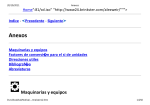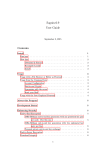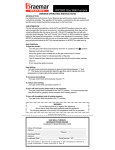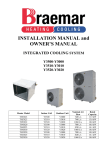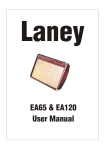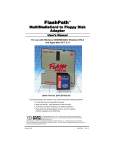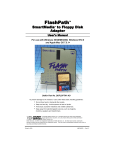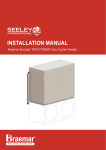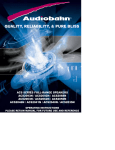Download Breamer Down Series Instruction manual
Transcript
ROOFTOP NAT U RAL AIR CONDITIONERS OWNERS INSTRUCTION MANUAL FOR FIXED INSTALLATION COMMERCIAL AND RESIDENTIAL EVAPORATIVE AIR CONDITIONERS How to Operate Using Your Air Conditioner Getting the Best Results Help Installation Report/Service “EA” series PLEASE KEEP THESE INSTRUCTIONS FOR FUTURE REFERENCE by IMPORTANT OWNER MATERIAL: This booklet must be given to the owner. “EA” Introduction........................................................1 How to Operate.................................................2 Getting the Best Results...................................2 Troubleshooting................................................3 Installation Report.............................................4 1 Index “EA” Hello and congratulations on purchasing a Braemar Ducted Cooler for your home. Braemar coolers have been designed to provide quiet, reliable and cool comfort. At Seeley International we manufacture Braemar evaporative coolers from the highest quality materials, and we have designed the product to provide many years of economical, trouble free cooling. Please take a few moments to read these operating instructions, so that the most can be gained from this investment. The appliance is not intended for use by persons (including children) with reduced physical, sensory or mental capabilities, or lack of experience and knowledge, unless they have been given supervision or instruction concerning the use of the appliance by a person responsible for their safety. Children should be supervised to ensure they do not play with the appliance. Braemar coolers are fitted with either a Variable Speed Control or a 2 Speed Control. Please refer to the relevant section in this manual for instructions on how to operate either system. Also, please be aware of the components and features that are fitted to your particular cooler. Keep these instructions in a safe place for future reference. 1 Introduction 1 EFFECTIVE COOLING To provide efficient cooling or ventilation the building must have sufficient exhaust openings to the outside of the building. To assist air flow, open windows and doors that are farthest from the outlet vent in each room. In these rooms, provide an exhaust opening about 2 times the vent size of the room. Where the design of the building prevents adequate exhaust, consideration should be given to the provision of mechanical extractions, such as an exhaust fan. Important Notes! In areas where temperatures can cause water supply pipes to freeze, a drain down facility should be provided during the installation. This drain down facility must be activated prior to freezing conditions, to avoid possible damage to the cooler components. “EA” 1 How To Operate 2 Two Speed and Variable Speed Units. Using Your Air Conditioner Your evaporative air conditioner has control switches to provide for the benefits of fresh air ventilation and cooling at high and low air flows. There are two types of control switches available: Two Speed (Fig. 1) and Variable Speed (Fig. 2). Evaporative air conditioners provide very effective cooling by drawing outside air through filter pads saturated with water. This water washes the air and cools it by the process of evaporation. There are a number of operating techniques and circumstances of which you should be aware to get the best performance from your evaporative air conditioner. Your control panel offers independent control for the fan and cooling functions. To provide effective cooling or ventilation, the air conditioner must be operated with sufficient openings to exhaust the air. For example: windows, doors or ducts. The location of the opening(s) will determine the pattern of cool air flow. The following are the minimum opening sizes required in square metres: UNIT EA90 EA120 EA 150 2 AREA (m ) 0.4 0.6 0.8 In light wind conditions more cooling can be obtained by opening additional windows and doors. In windy conditions close openings facing the wind. Generally, openings opposite the supply vents are best. Some experimentation will soon show the arrangement most suited to your requirements. For a multiple outlet system, this is generally 1 (one) window opened 100 to 150 mm per outlet. To Start the Air Conditioner (1) Switch the COOL control on. (2) Turn on the AIR (fan) control and using the SPEED switch (HI/LO switch or variable knob), select the fan speed you reqire. When ventilation only is required (air flow with no cooling) turn the COOL switch off, and select the fan speed to provide the air flow you require. To Stop the Air Conditioner Switch the COOL control off, then switch the AIR control off. For a short time, when operating with new filter pads, you may detect an odour like "wet timber”. This is the filter material becoming conditioned to use. In many areas the water supply is quite hard. When this water is evaporated through the filter pads, the hardness is deposited as a scale on the pad. To reduce this scale build-up and to retain efficient filter pads a small amount of water is bled from the system. The continuous drain of small amounts of water ensures that fresh water is added to dilute any build-up of scale or salts. The bleed rate for your air conditioner will depend on local operating conditions and will be adjusted during installation. “EA” Maintenance To ensure that your air conditioner continues to provide reliable service for many years, it requires some routine maintenance. There are two forms of maintenance: (1) pre and post season maintenance, and (2) preventative maintenance. Pre-season Maintenance (1) Turn off the water supply. (2) Turn off the power supply. (3) Remove the filter pad frames. Insert a screwdriver into the slots at the bottom of the pad frames and lever upwards. Pull the bottom of the pad frames away from the unit, then lower the frames out of the cabinet (Fig. 3). (4) Turn off the isolating switch. (5) Hose both sides of the filter pads CAREFULLY (do not use excess water pressure as this may create "holes" in the pad material). Ensure that the wood wool pad material is evenly distributed, especially make sure that there is no gaps or holes at the TOP of PADS. (6) Check and, if necessary, clean the water spreaders located inside the roof above the filter pads. (7) Drain the water from the unit by removing the overflow or overflow bleed funnel. Do not replace this item until next season. Do not lose the "O" ring seal. 1 Getting the Best Results 3 (11) Replace filter pad frames. Ensure they are the correct way up. (12) If water flow appears low, there may be a problem with foreign material clogging the pump or pump strainer. To correct, remove pump, dismantle base, clean and reassemble. Post-season Maintenance ! Turn off the power supply to the cooler. ! Remove pad frames ! Turn off the isolating switch inside the cooler. ! Remove pad frames. Clean them by hosing them with clean water, but do not use excess pressure because you might create holes in the pad media. ! Remove and clean the special water "spreader" plates located under each edge of the top panel. Do not disconnect from water hose. When replacing them, check underneath to see that the spreaders are correctly located in the notches under the top panel. ! Drain all the water form the cooler by removing the overflow or overflow bleed funnel. Do NOT put it back until next season. Do not lose the O-ring seal. ! Disconnect the water supply pipe from the tank. Make sure no water is left in the float valve. ! Clean the bottom tank thoroughly. ! Replace pads frames. (8) Check pulleys for wear and correct alignment. ! Cover the cooler for winter if desired. (9) Check "V" belt for wear. Preventative Maintenance: All units can benefit from routine preventative maintenance. This may be required more frequently if you are operating under harsh conditions. To perform Preventative Maintenance, follow the instructions for ‘Pre-Season Maintenance’ at regular intervals. (10) Thoroughly clean and dry the bottom of the water tank. Check Your Local Regulations: In some areas and for some commercial installations local regulations have specific requirements for the maintenance of evaporative air conditioning systems. Generally these involve regular cleaning and maintenance at (3) monthly intervals or more frequently if necessary. 3 “EA” 1 Troubleshooting 4 It will not take long for you to get to know the features of your air conditioner, but in case you encounter difficulties here are a few hints to help keep you cool: PROBLEM POSSIBLE CAUSE SUGGESTED REMEDY Inadequate cooling. Dry pads, or lack of water while air conditioner operating. Check that the tap is turned on. Check pump and pump strainer. Check water distribution systems. Ensure pump (COOL) is turned on. Insufficient air discharge openings to allow air to exhaust from areas being cooled. Adjust door / window opening. Pads shrunk away from the top corners (woodwool pads only). Tease the woodwool out evenly or replace pads. Air restriction in ductwork. Call Dealer to investigate and rectify. Clogged or Dirty Filter pads. Clean or replace pads. Circuit breaker tripped or unit fuse blown. Replace the fuse specific to that unit.(See Braemar Installation Manual). Broken fan belt Replace belt. Electrical fault. Call Service (see Page 5). Insufficient water reaching filter pads. Ensure water supply to unit is turned on. Clean pump filter. Pump failure. Call Service to repair. Fan stops and then restarts. Motor overload. The fan motor is fitted with an automatic thermal overload protector which will be reset when the motor cools down. If the motor stops and starts continuously, it should be investigated for a fault by a qualified Technician. Continuous overflow of water. Float valve adjustment. Incorrect bleed rate. Adjust float valve. Adjust bleed rate. Included on each bleed tray are plastic plugs with matching holes. With all plugs inserted, bleed rate is maximum. If you decide that the amount of bleed is too much, remove the plug/s from the bleed tray one at a time until the desired amount is achieved. No air flow. Air flow, but not cool. “EA” 1 Installation Report 5 CHECKLIST • Unit level and secure. Owners Name: • All roof or other penetrations properly sealed. • Ductwork completed and air Telephone: Address: distribution checked and outlets correctly set. • Mains wiring complete. Dealer: • Control switch correctly installed. • Belt tension and alignment correctly adjusted. Installer: Date Installed: • Fan runs in correct direction at all speeds (clockwise when viewed from pulley side). Model No.: Serial No.: • Motor power (tong) tested. • Power input to motor recorded High Low amps. amps. • Motor pulley adjusted and tight on Shaft. • Water bleed/drain/overflow fitting correctly installed. If you have followed the instructions and still have problems, the Braemar service network is only a phone call away. They can help with any aspect of operation you may not be sure of, or arrange for a service person to fix any faults. However, please bear in mind that if a service call reveals no fault with the Braemar unit, you may be charged for the call, even during the warranty period. In the first instance we recommend you contact the retailer from whom you purchased the unit. They will be familiar with your installation and will be anxious to rectify any difficulties. • Water level and float adjustment checked. EELE Y S • Filter material (wood wool) evenly packed in all pad frames. • Pump runs and water evenly distributed to all filter pads. • lt/min. All control functions checked. • Owner instructed in correct operating procedure . E ER VIC S • Bleed rate adjusted to FREECALL 1300 650 644 For all your Braemar warranty and service needs. Or contact your local Braemar dealer direct Braemar Evaporative Air Cooling Manual. Seeley International Pty Ltd, Adelaide, South Australia. ACN 054 687 035. As the policy of the company is one of continuous product improvement, all specifications are subject to change without notice. 859972-A AU 1007









